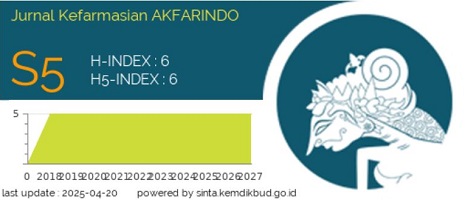SINTESIS DAN UJI AKTIVITAS ANTIBAKTERI SENYAWA KALKON TERHADAP BAKTERI KONTAMINAN PRODUK DARAH GRAM NEGATIF DAN POSITIF
Abstract
Background: The development of chalcone-based antibiotics has been widely carried out today, variations in the location and type of functional groups were carried out to find chalcone with the best bacterial inhibitory activity. However, the obstacle faced was that not all variations of chalcone showed good bacterial inhibitory activity. The trend of increasing or decreasing antibacterial activity due to variations in the location and type of substituent in chalcone is difficult to detect, because comparative data on the inhibitory activity of chalcone are not current or are no longer relevant to current conditions where the test bacteria have mutation as a form of adaptation or resistance to antibiotics. Objective: This research was conducted to provide current data on the antibacterial activity of chalcone against gram-positive and gram-negative bacteria. Methods: Chalcone was synthesized by Claisen-Schmidt condensation and activity test by diffusion method. Results: The yield of chalcone obtained in this study was 96.15%, with the percent purity based on the results of GC-MS was 100%. Inhibitory activity of chalcone on gram-negative bacteria Escherichia coli is in the strong category with an inhibitory value of 81.30% while Acinetobacter is weak with a percentage of 43.0%. In gram-positive bacteria Staphylococcus aureus the inhibitory ability is moderate with a percentage of 64.0%, while in Staphylococcus epidermidis and Bacillus sp the inhibitory activity is weak with a percentage of 35.5% and 43.0%, respectively. Conclusion: Chalcone have strong activity on Gram-negative bacteria and tend to be moderate on Gram-positive bacteria.
References
Carbon, C. and Isturiz, R. (2002) ‘Narrow versus broad spectrum antibacterials: Factors in the selection of pneumococcal resistance to β-lactams’, Drugs, 62(9), pp. 1289–1294. doi: 10.2165/00003495-200262090-00001.
Dan, W. and Dai, J. (2020) ‘Recent developments of chalcones as potential antibacterial agents in medicinal chemistry’, European Journal of Medicinal Chemistry, 187, pp. 1–20. doi: 10.1016/j.ejmech.2019.111980.
Dirga, D. et al. (2021) ‘Evaluasi Penggunaan Antibiotik pada Pasien Rawat Inap di Bangsal Penyakit Dalam RSUD. Dr. H. Abdul Moeloek Provinsi Lampung’, Jurnal Kefarmasian Indonesia, 11(1), pp. 65–75. doi: 10.22435/jki.v11i1.3570.
Ferraz, C. A. N. et al. (2020) ‘Potentiation of antibiotic activity by chalcone (E)-1-(4′-aminophenyl)-3-(furan-2-yl)-prop-2-en-1-one against gram-positive and gram-negative MDR strains’, Microbial Pathogenesis, 148(April). doi: 10.1016/j.micpath.2020.104453.
Ikhtiarudin, I. et al. (2020) ‘Microwave-assisted synthesis of 1-(4-hydroxyphenyl)-3-(4-methoxyphenyl)prop-2-en-1-one and its activities as an antioxidant, sunscreen, and antibacterial’, Jurnal Kimia Sains dan Aplikasi, 23(2), pp. 51–60. doi: 10.14710/jksa.23.2.51-60.
Kusumaningrum, S. B. C. and Sepvianti, W. (2020) ‘Identifikasi Bakteri Kontaminan Pada Produk Darah Thrombocyte Concentrate’, 10(2).
Messacar, K. (2018) ‘Narrow-spectrum, compared with broad-spectrum, antibiotics equally effective with less adverse events’, Journal of Pediatrics, 196, pp. 324–327. doi: 10.1016/j.jpeds.2018.02.054.
Novard, M. F. A., Suharti, N. and Rasyid, R. (2019) ‘Gambaran Bakteri Penyebab Infeksi Pada Anak Berdasarkan Jenis Spesimen dan Pola Resistensinya di Laboratorium RSUP Dr. M. Djamil Padang Tahun 2014-2016’, Jurnal Kesehatan Andalas, 8(2S), p. 26. doi: 10.25077/jka.v8i2s.955.
Nuryah, A., Yuniarti, N. and Puspitasari, I. (2019) ‘Prevalensi dan Evaluasi Kesesuaian Penggunaan Antibiotik pada Pasien dengan Infeksi Methicillin Resistant Staphylococcus Aureus di RSUP Dr. Soeradji Tirtonegoro Klaten’, Majalah Farmaseutik, 15(2), p. 123. doi: 10.22146/farmaseutik.v15i2.47911.
Rasyidah, R. (2014) ‘Pola Kuman dan Uji Kepekaan Antibiotik pada Sepsis Neonatorum di Unit Perawatan Neonatus RSUD dr. Pirngadi Kota Medan’, Sari Pediatri, 15(5), pp. 341–344. doi: 10.14238/sp15.5.2014.341-4.
Rossiter, S. E., Fletcher, M. H. and Wuest, W. M. (2017) ‘Natural Products as Platforms to Overcome Antibiotic Resistance’, chem Rev, 176(3), pp. 12415–12474. doi: 10.1021/acs.chemrev.7b00283.Natural.
Sepvianti, W. and Kusumaningrum, B. S. C. (2021) ‘SYNTHESIS AND ANTIBACTERIAL ACTIVITIES TEST OF CHALCONE (E)-3-(4- (DIMETHYLAMINO)PHENYL)-1-PHENYLPROP-2-EN-1-ONE AGAINST BACTERIA CONTAMINANT BLOOD PRODUCTS’, Journal of Health, 8(2), pp. 75–84.
Sepvianti, W., Kusumaningrum, B. S. and Christiyani (2021) ‘Analog Kalkon (E)-1,3-bis(4-hydroxyphenyl)prop-2-en-1-one: Sintesis dan Uji Aktivitas Antimicrobia terhadap Bakteri Kontaminan Produk Darah Analog’, Jurnal Kesehatan Saelmakers PERDANA, 4(2), pp. 321–328. doi: 10.32524/jksp.v4i2.287.
Setyawati, A., Wahyuningsih, T. D. and Purwono, B. (2017) ‘Synthesis of Novel Pyrazolines as Antibacterial Agents from Natural Product Vanilin’, Asian Journal of Chemistry, 29(2), pp. 454–456.
Xu, M. et al. (2019) ‘Chalcone derivatives and their antibacterial activities: Current development’, Bioorganic Chemistry, 91(April), p. 103133. doi: 10.1016/j.bioorg.2019.103133.
Copyright (c) 2022 Wiwit Sepvianti, Serafica Btari Christiyani Kusumaningrum (Author)

This work is licensed under a Creative Commons Attribution-ShareAlike 4.0 International License.















